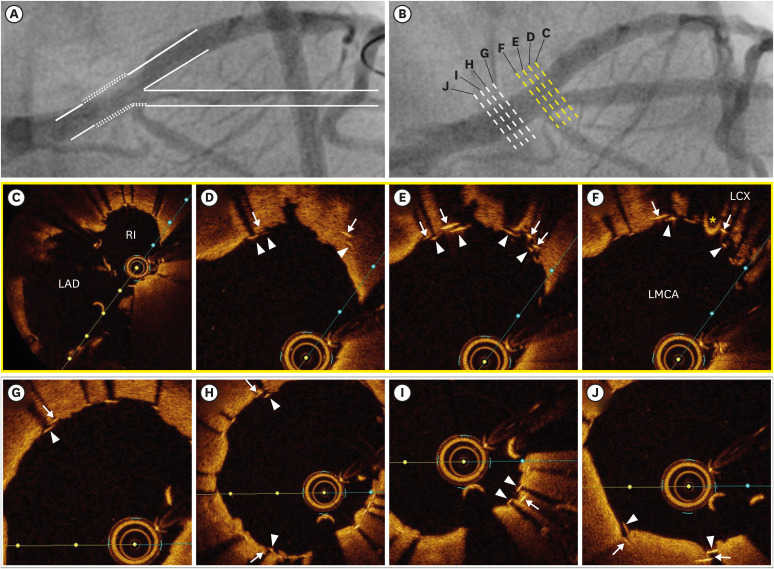 | Figure 1(A) The concept of culotte stenting (line with dots: 2 layers of struts). (B) Final coronary angiography after stenting using the culotte technique. (C) Left main bifurcation area between the ostial LAD and RI. (D, E) Two layers of struts from the RI to LCX. (F) Left main bifurcation area with the ostial LCX (asterisk: guidewire coming from the LCX). (G-J) Two layers of struts in the ULMCA shaft.(arrows: struts of the implanted stent from the ULMCA to RI; arrowheads: struts of implanted stent from the ULMCA to LAD)
LAD = left anterior descending artery; LCX = left circumflex artery; ULMCA = unprotected left main coronary artery; RI = ramus intermedius artery.
|
A 41-year-old man presenting with new-onset effort angina was referred to our clinic. Angiography revealed a left main trifurcation lesion including significant stenosis in the unprotected left main coronary artery (ULMCA), ostial left anterior descending artery (LAD), ostial left circumflex artery (LCX) with grade 3 collateral flow from the right coronary artery, and diffuse ramus intermedius artery (RI) (Supplementary Video 1). After an 8-French extra backup guiding catheter with a side hole was engaged into the left coronary artery via the right femoral approach, plain old balloon angioplasty (POBA) was performed from the ULMCA to LAD, LCX, and RI, respectively. Optical coherence tomography (OCT) demonstrated successful POBA for ostial LCX; thus, percutaneous coronary intervention (PCI) was planned with the 2-stent culotte technique from the ULMCA to the LAD and RI, rather than the crush technique, because 3 strut layers should be avoided on the ostial LCX (Figure 1A). A 3.0×38 mm everolimus-eluting stent (EES; Xience Sierra®, Abbott Vascular) was implanted from the ULMCA to the RI. Subsequently, a 3.5×18 mm EES implantation from the ULMCA to the LAD was achieved with the culotte technique. After stent optimization with kissing balloon inflation and the proximal optimization technique, the final angiography showed no residual stenosis (Figure 1B and Supplementary Video 2), and post-stenting OCT demonstrated a minimized neo-carina between the ostial LAD and RI (Figure 1C) and two strut layers from the distal left main trunk to the shaft including the ostial LCX (Figure 1D-J).
The high resolution (10 µm) of OCT can provide detailed post-PCI information, including stent apposition and edge dissections, but there are limited data regarding the OCT-guided PCI with two-stent technique for the bifurcation lesion, especially ULMCA.1)2) This case highlights the feasibility of OCT-guided complex PCI and OCT images of successful culotte technique.
Notes
Author Contributions:
Conceptualization: Kim Y.
Data curation: Kim Y, Kim BK.
Formal analysis: Kim Y.
Investigation: Kim Y.
Methodology: Kim BK.
Project administration: Kim BK.
Supervision: Kim BK, Hong SJ, Kim JS, Cho DK.
Visualization: Kim Y.
Writing - original draft: Kim Y.
Writing - review & editing: Kim BK, Hong SJ, Kim JS, Cho DK, Choi D, Hong MK, Jang Y.
Go to : 
References
1. Lee CH, Hur SH. Optimization of percutaneous coronary intervention using optical coherence tomography. Korean Circ J. 2019; 49:771–793. PMID: 31456372.

2. Kim Y, Johnson TW, Park SH, et al. Optical coherence tomography findings of non-ST elevation myocardial infarction with multivessel disease. Korean Circ J. 2020; 50:88–90. PMID: 31854159.

Go to : 




 PDF
PDF Citation
Citation Print
Print




 XML Download
XML Download